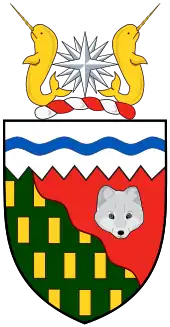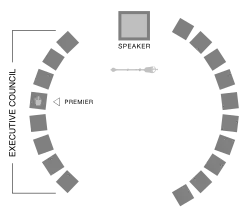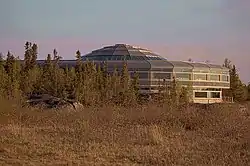Legislative Assembly of the Northwest Territories
The Northwest Territories Legislative Assembly, or Legislative Council of the Northwest Territories (with Northwest hyphenated as North-West until 1906),[3][4] is the legislature and the seat of government of Northwest Territories in Canada.[5] It is a unicameral elected body that creates and amends law in the Northwest Territories. Permanently located in Yellowknife since 1993, the assembly was founded in 1870 and became active in 1872 with the first appointments from the Government of Canada.
Northwest Territories Legislative Assembly
List
| |
|---|---|
| 19th Northwest Territories Legislative Assembly[2] | |
 | |
| Type | |
| Type | |
| Leadership | |
Frederick Blake Jr. since October 2019 | |
| Structure | |
| Seats | 19 |
 | |
Political groups | None
|
| Elections | |
Last election | October 1, 2019 |
Next election | November 14, 2023 |
| Meeting place | |
 | |
| Legislative Building, Yellowknife, Northwest Territories, Canada | |
| Website | |
| www | |
Until 2014, the assembly was officially defined under federal law as "Legislative Council". However, under Northwest Territories territorial law, it was defined as "Legislative Assembly". The federal name was changed when the Northwest Territories Act was rewritten in 2014. Under different periods of its history it has alternated names.
Members of the Legislative Assembly are sworn in by the commissioner of the Northwest Territories.
Early history
The Legislative Assembly was first known as the Temporary North-West Council and was created in 1870. The first appointments to the council were made on December 28, 1872. The Temporary Council was dissolved in 1876 and a new permanent council was appointed and moved to the new capital of Fort Livingstone in 1876. The council moved to Battleford a year later based on the planned location there of the Canadian Pacific Railway.
The very first election to the Assembly would take place on March 23, 1881, as Lawrence Clarke was elected to represent the electoral district of Lorne. In 1883 the Assembly moved south to Regina based on amendments to the route of the railway. The first territory-wide election took place on September 15, 1885, known as the 1885 Northwest Territories election.
Three years later the first general election took place. All the voting members of the Assembly were elected for the first time, and an elected speaker took office. The Lieutenant Governor still had executive authority however and appointed and ran the cabinet. After the second general election in 1891 the first fully elected Assembly without any appointed members. The Assembly achieved Responsible Government for the first time in October 1897 as the Lieutenant Governor appointed Frederick Haultain as the first Premier to form a government. Robert Brett became the first Leader of the official opposition and party lines were roughly drawn based on Conservatives and Liberals.
The Haultain government lobbied for Government of Canada for provincial powers for the Northwest Territories. In response on September 1, 1905, the provinces of Alberta and Saskatchewan were created by Prime Minister Wilfrid Laurier out of the southern populated portion of the territories.
Court of law
The Northwest Territories Legislative Assembly served as the first court of law in the Northwest Territories from 1876 until the creation of the Supreme Court of the Northwest Territories in 1887. Appointed members of the council served as stipendiary magistrates would travel the territories and oversee legal cases when the Legislature was not sitting. In 1887 the Northwest Territories moved to a new system that assigned judges to judicial districts and separated the legal and judicial branches.
Ottawa
After the creation of Alberta and Saskatchewan, the remainder of the Northwest Territories was too sparsely populated by enfranchised voters to justify holding elections. The territory reverted to its confederation entry status. A new council was set up in Ottawa consisting of a Commissioner—the effective replacement of the Lieutenant Governor—and four appointed members.
Frederick White was appointed as the first Commissioner and did not recall the council to sit during his time in office. During this time, the Territories were run by the federal Department of Mines and Resources. The first session of the Council of the Northwest Territories took place in 1921. The council members were bureaucrats appointed from the Interior Ministry and were not resident citizens of the territory.
In 1939, the Yellowknife Administration District was created to provide services within 25 miles of Yellowknife. However, it was not until 1947 that John G. McNiven was appointed to represent the district. McNiven was the first member appointed to the council from north of the 60th parallel.
In 1951 the council held its first general election in 49 years. The fifth general election elected three members from the District of Mackenzie. The old council was completely dissolved and five members were appointed along with the three elected representatives.
The council gradually gained more powers back from the federal government as the population in the territory grew. In 1967 the Carrothers Commission moved the territorial capital from Ottawa to Yellowknife and for the first time elected members represented all parts of the territories. In 1975 the Legislative Assembly became fully elected, and the first elected speaker since 1905, David Searle, presided over the Assembly.
Consensus government
Commissioner John Parker gave up his powers of running the executive council and appointed George Braden as leader of the government and the first premier since 1905. The model of responsible government that was used this time around was known as consensus government. The executive council or cabinet forms government while all the regular members form an unofficial opposition.
The modern consensus government model is inherently non-partisan and serves effectively as a constant minority government. The legislature uses this model up to the current day; the same model of government is also used in the Legislative Assembly of Nunavut, although Canada's other territorial legislature, the Legislative Assembly of Yukon, uses a traditional partisan politics model.
The consensus government model has received criticism on various grounds, including that it hampers long-term political and economic development in the territory because the lack of political parties mean that there is no mechanism to carry over a political agenda from one assembly to the next;[6] that it complicates the ability of less wealthy citizens to serve in the assembly because the lack of political parties means that election candidates must raise all of their campaign funds on their own;[7] that it prevents the voters from being able to demand or vote for systemic change, since there is no mechanism to replace an ineffective or underperforming government with another alternative;[6] and that it hampers efforts to improve diversity in representation, such as the election of more women and ethnic minorities to the legislature.[8]
In 2018, MLA Kieron Testart introduced an amendment to the territorial Elections Act to permit the introduction of party politics in the legislative assembly,[9] but his motion received no support from other MLAs and was dropped.[7] In 2019, he planned to organize a group of ideologically aligned MLA candidates in the 2019 Northwest Territories general election into a "Liberal Democratic" slate,[10] but backed off of the plan after it was leaked to the press.[11]
Assembly buildings

The building that has housed the Northwest Territories Legislative Assembly has changed many times since it was founded. The first building was the original Manitoba Legislature in Fort Garry. After the council moved to Fort Livingstone it was housed in the Swan River Barracks used by the North-West Mounted Police.
The first building built for the needs of the Assembly was NWT Government House in Battleford. That building also served as a residence for the Lieutenant Governor. In 1883 the Assembly moved to Regina. The Territorial Administration building was built to accommodate the growing Assembly and used until 1905.
After the creation of Alberta and Saskatchewan, the capital was moved to Ottawa and the council sessions took place in an office building on Sparks Street. When the council sessions returned to the territories, they were held in any infrastructure suitable as they traveled from community to community.
After the capital was moved to Yellowknife in 1967 a temporary site for the Legislative Assembly was used until the new Legislature building was finished in 1993. The design of the current Legislature building was created by Pin/Taylor Architects company from Yellowknife.
Current membership

The membership of the 19th Northwest Territories Legislative Assembly, was selected in the 2019 Northwest Territories general election on October 1, 2019. A 2021 by-election was held for the electoral district of Monfwi.[12]
Each member represents one electoral district.
The territories has fixed election date legislation that ensures elections are held every four years on the first Monday in October.[13]
The legislature since 1905 is a non-partisan body and all members run and sit as independents.


Cabinet Ministers
The seven ministers of the Government of the NWT are found in the Executive Council of the Northwest Territories.
See also
References
- Northwest Territories Legislative Assembly
- "Legislative Assembly of the NWT". Legislative Assembly of the Northwest Territories. Retrieved 2015-03-13.
- "History of the Name of the Northwest Territories". Prince of Wales Northern Heritage Centre. Retrieved 2021-11-01.
- c.62, RSC 1906
- "About the Legislative Assembly". Legislative Assembly of the Northwest Territories. Retrieved 2017-03-13.
- "Consensus government must be improved". Northern Journal, May 11, 2015.
- "Zero support from MLAs for motion to introduce party politics in N.W.T.". CBC North, October 30, 2018.
- "A Few Good Women: The Gender Problem in NWT Politics". Edge YK, December 4, 2015.
- "N.W.T. MLA will introduce bill to allow political parties, scrap consensus gov't". CBC News, October 25, 2018.
- Richard Gleeson, "Leaked document shows N.W.T. MLA leading push for party politics". CBC North, March 5, 2019.
- Randi Beers, "N.W.T. MLA steps back from move toward party politics". CBC North, August 9, 2019.
- Zingel, Avery. "Byelection win takes women to a majority in N.W.T. legislature — a 1st for Canada". CBC News. Retrieved 5 October 2021.
- Fixed election date in the N.W.T.: What does it mean, and why? Archived 2007-07-03 at archive.today
Further reading
- Lingard, Charles Cecil (1946). Territorial government in Canada: the autonomy question in the old North-West Territories. Toronto: University of Toronto Press. OCLC 577721800.
- Thomas, Lewis H. (1978). The struggle for responsible government in the North-West Territories, 1870–97 (2nd ed.). Toronto: University of Toronto Press. ISBN 978-0-8020-2287-5.
- "Territories" (PDF). Provincial Archives of Saskatchewan. 2009.
